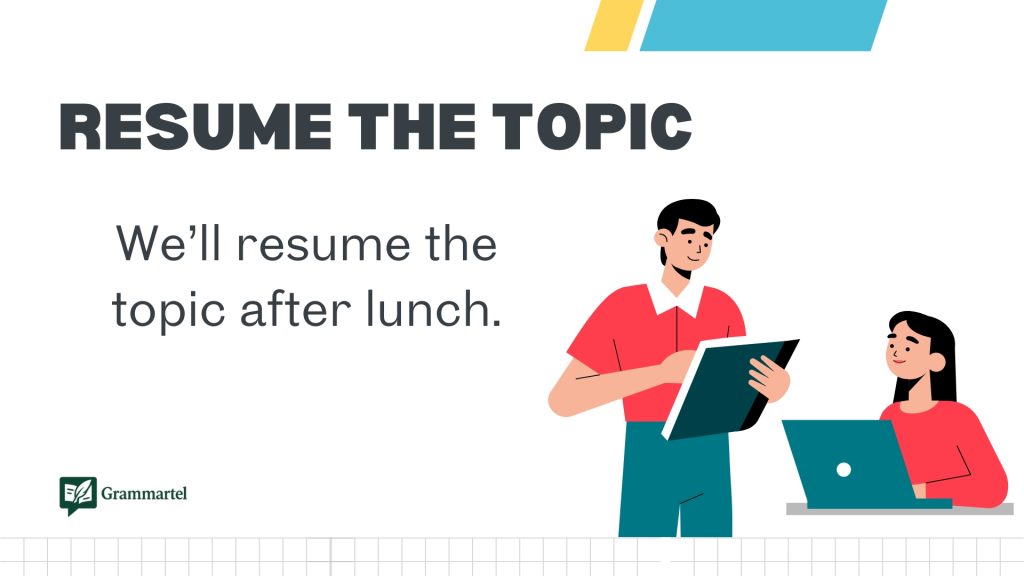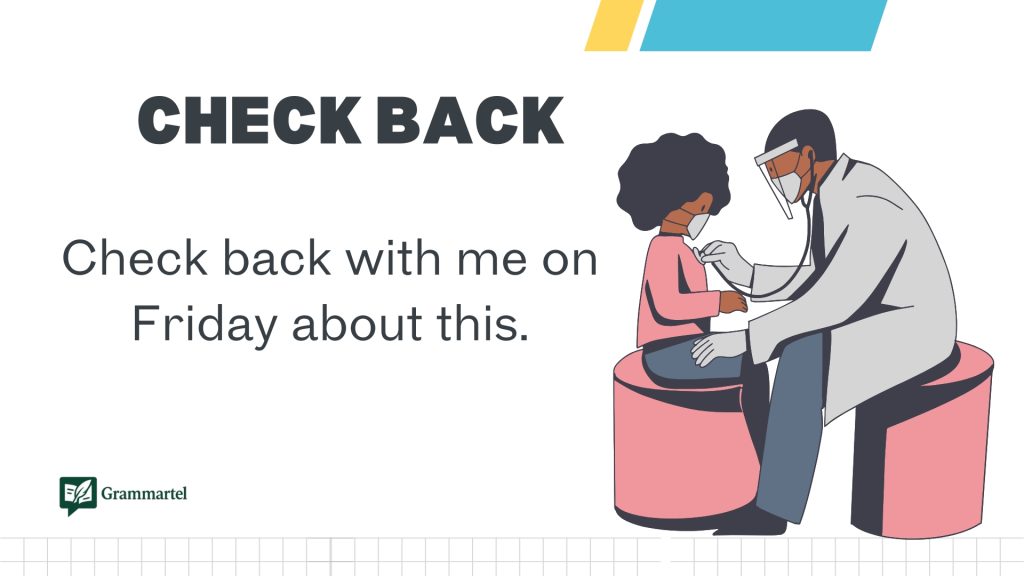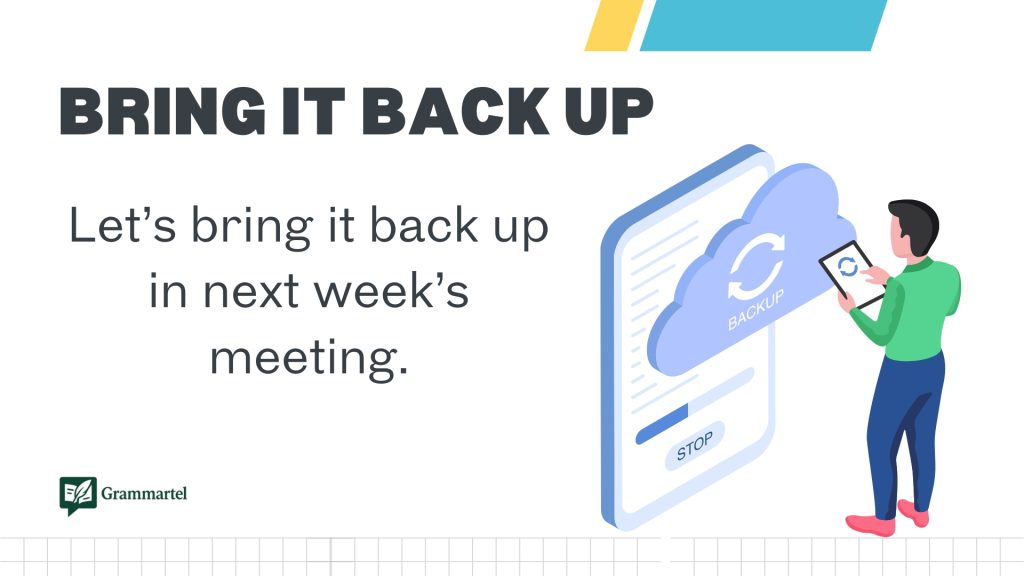We’ve all had moments in work emails or meetings where we want to check in on something without sounding pushy. The phrase “circle back” has become a go-to, but let’s be honest—it’s starting to feel a bit worn out. Using the same words again and again can make your message sound less fresh and less personal. That’s why having different ways to say the same thing can help you sound polite, clear, and professional. Whether you’re reminding a client, following up with a teammate, or re-opening an old topic, a little variety in language can go a long way.
What Does “Circle Back” Mean?
“Circle back” is a common phrase in work talks or emails. It means to return to a topic, task, or question later. People use it when something needs more time, more details, or a final answer. It can also mean checking in again after some progress is made.
When to Use “Circle Back”
You can use “circle back” when you need to follow up on a project, confirm details, or revisit a decision. It works well in meetings, emails, or quick chats. It’s polite because it shows you remember the topic and want to keep it moving, without pressing for an immediate reply.
40 Polite Ways to Say “Circle Back”
1. Follow up
Meaning: Check on something after some time.
Explanation: Used to remind or get an update politely.
Example: “I wanted to follow up on last week’s request.”
Best Use: Email updates to clients or teammates.
Worst Use: Casual chats with friends.
Tone: Polite and professional.
2. Touch base
Meaning: Make brief contact to update or confirm.
Explanation: Often used for quick status checks.
Example: “Let’s touch base tomorrow about the report.”
Best Use: Short check-ins in work settings.
Worst Use: Formal letters.
Tone: Friendly and informal.
3. Check in
Meaning: See how something is going.
Explanation: Works for personal or work updates.
Example: “Just checking in to see if you need help.”
Best Use: Project updates or casual reminders.
Worst Use: Legal or formal notices.
Tone: Warm and caring.
4. Get back to
Meaning: Return to a topic later.
Explanation: Direct but still polite.
Example: “I’ll get back to you on this after lunch.”
Best Use: Quick follow-ups in casual or work talk.
Worst Use: Very formal writing.
Tone: Simple and straightforward.
5. Revisit
Meaning: Look at something again.
Explanation: Good for topics that need a fresh review.
Example: “Let’s revisit the budget next week.”
Best Use: Group meetings or planning talks.
Worst Use: Personal small talk.
Tone: Neutral and clear.
6. Return to
Meaning: Go back to a task or topic.
Explanation: Works for formal and informal use.
Example: “We can return to this after the call.”
Best Use: Meeting agendas.
Worst Use: Light casual chats.
Tone: Calm and neutral.
7. Continue our discussion
Meaning: Pick up where you left off.
Explanation: Clear for ongoing talks.
Example: “We’ll continue our discussion in tomorrow’s session.”
Best Use: Work or academic settings.
Worst Use: Very short exchanges.
Tone: Professional and smooth.
Read Next : 40 Best Ways to Say “My Availability Is as Follows” (With Examples).
8. Pick this up later
Meaning: Resume the topic later.
Explanation: Implies a pause, not a stop.
Example: “Let’s pick this up later in the day.”
Best Use: Meetings or brainstorming sessions.
Worst Use: Formal letters.
Tone: Light and casual.
9. Bring this up again
Meaning: Mention it once more.
Explanation: Good for gentle reminders.
Example: “I’ll bring this up again after the break.”
Best Use: Team discussions.
Worst Use: Highly formal events.
Tone: Friendly and easygoing.
10. Get an update on
Meaning: Ask for progress info.
Explanation: Great for tracking projects.
Example: “Can I get an update on the design changes?”
Best Use: Project tracking and management.
Worst Use: Social talks.
Tone: Professional but not cold.
11. Follow through
Meaning: Complete what was started.
Explanation: Suggests responsibility.
Example: “We need to follow through on the plan.”
Best Use: Work commitments.
Worst Use: Friendly chats.
Tone: Motivating and firm.
12. Resume the topic

Meaning: Start talking about it again.
Explanation: Works well in group settings.
Example: “We’ll resume the topic after lunch.”
Best Use: Meeting agendas.
Worst Use: Everyday casual talk.
Tone: Formal and clear.
13. Continue where we left off
Meaning: Start again at the last point.
Explanation: Good for paused conversations.
Example: “Let’s continue where we left off yesterday.”
Best Use: Meetings, classes, projects.
Worst Use: Brief casual chats.
Tone: Friendly and professional.
14. Address this later
Meaning: Deal with it at another time.
Explanation: Signals delay without losing track.
Example: “We’ll address this later in the week.”
Best Use: Scheduling talks.
Worst Use: Emotional conversations.
Tone: Neutral and calm.
15. Come back to
Meaning: Return to something.
Explanation: Easy to say, works in most cases.
Example: “Let’s come back to this tomorrow.”
Best Use: Light follow-ups.
Worst Use: Strictly formal writing.
Tone: Simple and direct.
16. Follow the thread
Meaning: Keep track of the same topic.
Explanation: Works in email or online chats.
Example: “Following the thread, have we approved this yet?”
Best Use: Ongoing digital talks.
Worst Use: Spoken small talk.
Tone: Professional and organized.
17. Touch on again
Meaning: Briefly mention again.
Explanation: Good for reminders.
Example: “We’ll touch on this again in the next meeting.”
Best Use: Recaps in discussions.
Worst Use: Urgent matters.
Tone: Light and polite.
18. Readdress
Meaning: Talk about again.
Explanation: Works for fixing or improving something.
Example: “We should readdress the policy next quarter.”
Best Use: Problem-solving meetings.
Worst Use: Friendly banter.
Tone: Serious and focused.
19. Reopen the discussion
Meaning: Start talking about it again.
Explanation: Good for paused debates or issues.
Example: “Let’s reopen the discussion about timelines.”
Best Use: Strategic talks.
Worst Use: Social conversations.
Tone: Formal and direct.
20. Review again
Meaning: Look over something once more.
Explanation: Great for documents or plans.
Example: “We should review the proposal again.”
Best Use: Work or school reviews.
Worst Use: Casual topics.
Tone: Professional and neutral.
21. Follow on
Meaning: Continue from a previous point.
Explanation: Often used in meetings or formal talks.
Example: “To follow on from our earlier chat, here’s the update.”
Best Use: Professional follow-ups.
Worst Use: Everyday small talk.
Tone: Formal and clear.
22. Keep in touch about
Meaning: Stay connected regarding a topic.
Explanation: Friendly way to keep communication open.
Example: “Let’s keep in touch about the launch date.”
Best Use: Ongoing projects.
Worst Use: Strict legal writing.
Tone: Warm and casual.
23. Check back

Meaning: Look into something again later.
Explanation: Good for casual reminders.
Example: “Check back with me on Friday about this.”
Best Use: Informal work chats.
Worst Use: High-stakes negotiations.
Tone: Relaxed and friendly.
24. Touch back
Meaning: Contact again after some time.
Explanation: Similar to “touch base” but for later.
Example: “I’ll touch back with you once I have the figures.”
Best Use: Friendly work emails.
Worst Use: Very formal situations.
Tone: Light and approachable.
25. Keep me posted
Meaning: Give updates when there’s news.
Explanation: Polite way to ask for progress.
Example: “Please keep me posted on any changes.”
Best Use: Casual and work settings.
Worst Use: Academic or legal writing.
Tone: Friendly and open.
26. Keep me updated
Meaning: Share new details as they come.
Explanation: Straightforward follow-up request.
Example: “Keep me updated on the supplier’s response.”
Best Use: Project tracking.
Worst Use: Playful chats.
Tone: Professional and clear.
27. Keep the conversation going
Meaning: Continue talking over time.
Explanation: Encourages ongoing discussion.
Example: “Let’s keep the conversation going about this idea.”
Best Use: Team brainstorming.
Worst Use: Quick one-off emails.
Tone: Engaging and upbeat.
28. Circle around to
Meaning: Come back to a topic naturally.
Explanation: Sounds casual but polite.
Example: “We’ll circle around to this later in the meeting.”
Best Use: Informal discussions.
Worst Use: Formal contracts.
Tone: Friendly and conversational.
29. Return for review
Meaning: Look over something again later.
Explanation: Formal way to request another check.
Example: “We’ll return for review next month.”
Best Use: Planning sessions.
Worst Use: Small talk.
Tone: Serious and professional.
30. Keep following up
Meaning: Continue to check progress.
Explanation: Encourages regular updates.
Example: “We’ll keep following up until it’s done.”
Best Use: Long-term projects.
Worst Use: Casual conversations.
Tone: Persistent yet polite.
31. Refer back to
Meaning: Look again at something mentioned before.
Explanation: Works for detailed topics.
Example: “Please refer back to the original brief.”
Best Use: Written instructions.
Worst Use: Light chats.
Tone: Formal and specific.
32. Loop back
Meaning: Come back to a topic in the conversation.
Explanation: Common in business talk.
Example: “Let’s loop back to this after the client call.”
Best Use: Internal meetings.
Worst Use: Casual social chats.
Tone: Neutral and modern.
33. Bring forward again
Meaning: Raise a topic once more.
Explanation: Useful for reminders in meetings.
Example: “I’d like to bring forward again the budget issue.”
Best Use: Group discussions.
Worst Use: Informal chats.
Tone: Direct and formal.
34. Raise again
Meaning: Mention the topic one more time.
Explanation: Short and clear reminder.
Example: “I’ll raise this again in tomorrow’s call.”
Best Use: Quick updates.
Worst Use: Playful conversations.
Tone: Straightforward.
35. Address once more
Meaning: Handle the same matter again.
Explanation: Best for important issues.
Example: “We’ll address this once more before the deadline.”
Best Use: Serious work settings.
Worst Use: Everyday talks.
Tone: Firm and professional.
36. Keep the thread alive
Meaning: Continue the same topic over time.
Explanation: Often used in email chains.
Example: “Let’s keep the thread alive until it’s resolved.”
Best Use: Digital correspondence.
Worst Use: In-person casual talk.
Tone: Professional but relaxed.
37. Come around to
Meaning: Eventually reach a topic.
Explanation: Feels natural and casual.
Example: “We’ll come around to that later.”
Best Use: Informal meetings.
Worst Use: Formal documents.
Tone: Light and friendly.
Explore More : 40 professional Ways to Say “Please Disregard My Previous Email” (With Examples).
38. Touch in again
Meaning: Contact again after a gap.
Explanation: Similar to “check in” but for later.
Example: “I’ll touch in again next week to see progress.”
Best Use: Work follow-ups.
Worst Use: Legal settings.
Tone: Warm and casual.
39. Keep checking on
Meaning: Continue to watch progress.
Explanation: Best for tasks in motion.
Example: “We’ll keep checking on the delivery schedule.”
Best Use: Long-term projects.
Worst Use: Personal topics.
Tone: Neutral and persistent.
40. Bring it back up

Meaning: Mention the matter again.
Explanation: Works for casual or semi-formal settings.
Example: “Let’s bring it back up in next week’s meeting.”
Best Use: Team updates.
Worst Use: Highly formal documents.
Tone: Simple and conversational.
Conclusion
Language shapes how people hear your message. Swapping “circle back” for other polite phrases keeps your tone warm, your intent clear, and your communication engaging. It’s not about changing the meaning—it’s about adding a personal touch and avoiding tired expressions. Next time you need to revisit a conversation or follow up, try one of these alternatives and watch how smoothly the dialogue flows. Words really do set the tone.
Where growth meets clarity,Where Grammartel leads the way.

